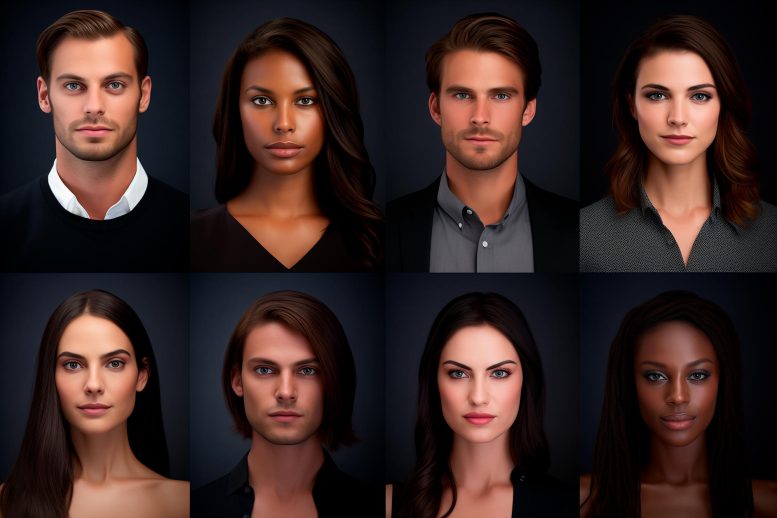
Researchers found that AI-generated white faces are perceived as more realistic than human faces, a trend not seen with faces of people of color. This image was generated by AI, specifically with Midjourney V5.2. Credit: SciTechDaily.com
White faces generated by artificial intelligence (AI) now appear more real than human faces, according to new research co-authored by a UCL academic.
In the study, led by the Australian National University researchers and published in Psychological Science, more people thought AI-generated faces were human than the faces of real people.
Co-author Dr. Eva Krumhuber (UCL Psychology & Language Sciences) said: “Artificial intelligence has reached an astonishing level of realism, and here we find that sometimes it can even seem more real than reality – hyperrealism – so that we can be very easily tricked into thinking an AI-generated face is real.”
For the study, the researchers showed 124 participants images of different white faces and asked them to judge if the face was real or generated by the StyleGAN2 algorithm. For the AI faces, participants judged them to be real two-thirds of the time – more often than for the real faces.
Racial Bias and the Perception of AI Faces
However, this pattern was not found in other research using the same algorithm that included faces of people of varying ethnicities. The reason for the discrepancy is that AI algorithms tend to be trained disproportionately on white faces.
Senior author Dr. Amy Dawel (Australian National University) said: “If white AI faces are consistently perceived as more realistic, this technology could have serious implications for people of color by ultimately reinforcing racial biases online.
“This problem is already apparent in current AI technologies that are being used to create professional-looking headshots. When used for people of color, the AI is altering their skin and eye color to those of white people.”
AI Hyper-Realism and Its Consequences
One of the issues with AI ‘hyper-realism’ is that people often don’t realize they’re being fooled, the researchers found.
Study co-author and PhD candidate at Australian National University, Elizabeth Miller, said: “Concerningly, people who thought that the AI faces were real most often were paradoxically the most confident their judgments were correct.”
“This means people who are mistaking AI imposters for real people don’t know they are being tricked.”
The researchers were also able to discover why AI faces are fooling people.
Dr. Krumhuber said: “In the old days, there would often be inconsistencies between artificial and human-like faces, thereby producing the uncanny valley effect. Particularly, the eyes (i.e., refraction, shadowing) would give away clues as to whether the face is real or artificial. It seems that we’ve now overcome the uncanny valley for static images.”
Dr. Dawel added: “It turns out that there are still physical differences between AI and human faces, but people tend to misinterpret them. For example, white AI faces tend to be more in-proportion and people mistake this as a sign of humanness. However, we can’t rely on these physical cues for long. AI technology is advancing so quickly that the differences between AI and human faces will probably disappear soon.”
Implications for Misinformation and Identity Theft
The researchers argue this trend could have serious implications for the proliferation of misinformation and identity theft, and that action needs to be taken.
Dr. Dawel said: “AI technology can’t become sectioned off so only tech companies know what’s going on behind the scenes. There needs to be greater transparency around AI so researchers and civil society can identify issues before they become a major problem.”
Raising public awareness can also play a significant role in reducing the risks posed by the technology, the researchers argue.
Dr. Krumhuber, whose research and teaching at UCL explores the socio-cognitive and affective processes underlying emerging technologies and their influence on the human mind, said: “Given that humans can no longer detect AI faces, society needs tools that can accurately identify AI imposters.”
Dr. Dawel concluded: “Educating people about the perceived realism of AI faces could help make the public appropriately skeptical about the images they’re seeing online.”
Reference: “AI Hyperrealism: Why AI Faces Are Perceived as More Real Than Human Ones” by Elizabeth J. Miller, Ben A. Steward, Zak Witkower, Clare A. M. Sutherland, Eva G. Krumhuber and Amy Dawel, 12 November 2023, Psychological Science.
DOI: 10.1177/09567976231207095










Skin tones and shadow lines are still too smooth. It’s a fake! 8k screens exposed that.